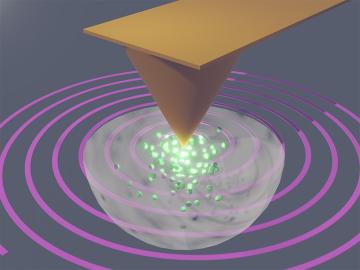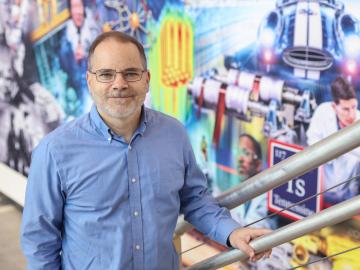Filter News
Area of Research
- Advanced Manufacturing (17)
- Biological Systems (4)
- Biology and Environment (50)
- Building Technologies (8)
- Chemical and Engineering Materials (1)
- Clean Energy (198)
- Climate and Environmental Systems (4)
- Computational Biology (1)
- Computational Engineering (3)
- Computer Science (12)
- Electricity and Smart Grid (2)
- Energy Sciences (4)
- Fossil Energy (1)
- Functional Materials for Energy (2)
- Fusion and Fission (17)
- Fusion Energy (8)
- Isotope Development and Production (1)
- Isotopes (10)
- Materials (143)
- Materials Characterization (2)
- Materials for Computing (14)
- Materials Under Extremes (1)
- Mathematics (1)
- National Security (16)
- Neutron Data Analysis and Visualization (2)
- Neutron Science (47)
- Nuclear Science and Technology (26)
- Nuclear Systems Modeling, Simulation and Validation (2)
- Quantum information Science (4)
- Renewable Energy (2)
- Sensors and Controls (2)
- Supercomputing (61)
- Transportation Systems (4)
News Type
Date
News Topics
- 3-D Printing/Advanced Manufacturing (48)
- Advanced Reactors (18)
- Artificial Intelligence (21)
- Big Data (18)
- Bioenergy (20)
- Biology (24)
- Biomedical (15)
- Biotechnology (3)
- Buildings (23)
- Chemical Sciences (20)
- Clean Water (13)
- Climate Change (26)
- Composites (13)
- Computer Science (55)
- Coronavirus (15)
- Critical Materials (12)
- Cybersecurity (9)
- Decarbonization (10)
- Energy Storage (46)
- Environment (57)
- Exascale Computing (4)
- Frontier (4)
- Fusion (17)
- Grid (23)
- High-Performance Computing (23)
- Hydropower (6)
- Irradiation (3)
- Isotopes (12)
- ITER (4)
- Machine Learning (12)
- Materials (67)
- Materials Science (51)
- Mathematics (1)
- Mercury (3)
- Microscopy (20)
- Molten Salt (6)
- Nanotechnology (24)
- National Security (10)
- Net Zero (1)
- Neutron Science (41)
- Nuclear Energy (34)
- Partnerships (6)
- Physics (10)
- Polymers (13)
- Quantum Computing (5)
- Quantum Science (14)
- Security (4)
- Simulation (11)
- Software (1)
- Space Exploration (11)
- Statistics (1)
- Summit (8)
- Sustainable Energy (50)
- Transformational Challenge Reactor (1)
- Transportation (44)
Media Contacts

Pablo Moriano, a research scientist in the Computer Science and Mathematics Division at ORNL, was selected as a member of the 2024 Class of MGB-SIAM Early Career Fellows.

The American Society of Heating, Refrigeration and Air-Conditioning Engineers, or ASHRAE, selected Jason DeGraw, a researcher with ORNL, as one of 23 members elevated to Fellow during its 2024 winter conference.

Research led by ORNL’s Marti Checa and Liam Collins has pioneered a groundbreaking approach described in the journal Nature Communications that enables visualizing charge motion at the nanometer level, or one billionth of a meter, but at speeds thousands of times faster than conventional methods.

David Sholl, director of the Transformational Decarbonization Initiative at ORNL, has been elected a member of the National Academy of Engineering for his contributions in addressing large-scale chemical separation challenges, including carbon dioxide capture, using quantitative materials modeling.

ORNL climate modeling expertise contributed to a project that assessed global emissions of ammonia from croplands now and in a warmer future, while also identifying solutions tuned to local growing conditions.

ORNL researchers have developed a novel way to encapsulate salt hydrate phase-change materials within polymer fibers through a coaxial pulling process. The discovery could lead to the widespread use of the low-carbon materials as a source of insulation for a building’s envelope.

Scientists at the Department of Energy’s Oak Ridge National Laboratory are using a new modeling framework in conjunction with data collected from marshes in the Mississippi Delta to improve predictions of climate-warming methane and nitrous oxide

Four ORNL teams and one researcher were recognized for excellence in technology transfer and technology transfer innovation.

Rigoberto “Gobet” Advincula, a scientist at the Department of Energy’s Oak Ridge National Laboratory, has been appointed a Fellow of the Institute of Materials, Minerals and Mining.

Gina Tourassi, associate laboratory director for computing and computational sciences at the US Department of Energy’s (DOE’s) Oak Ridge National Laboratory, has been named a fellow of the Institute of Electrical and Electronics Engineers, the world’s largest organization for technical professionals.




